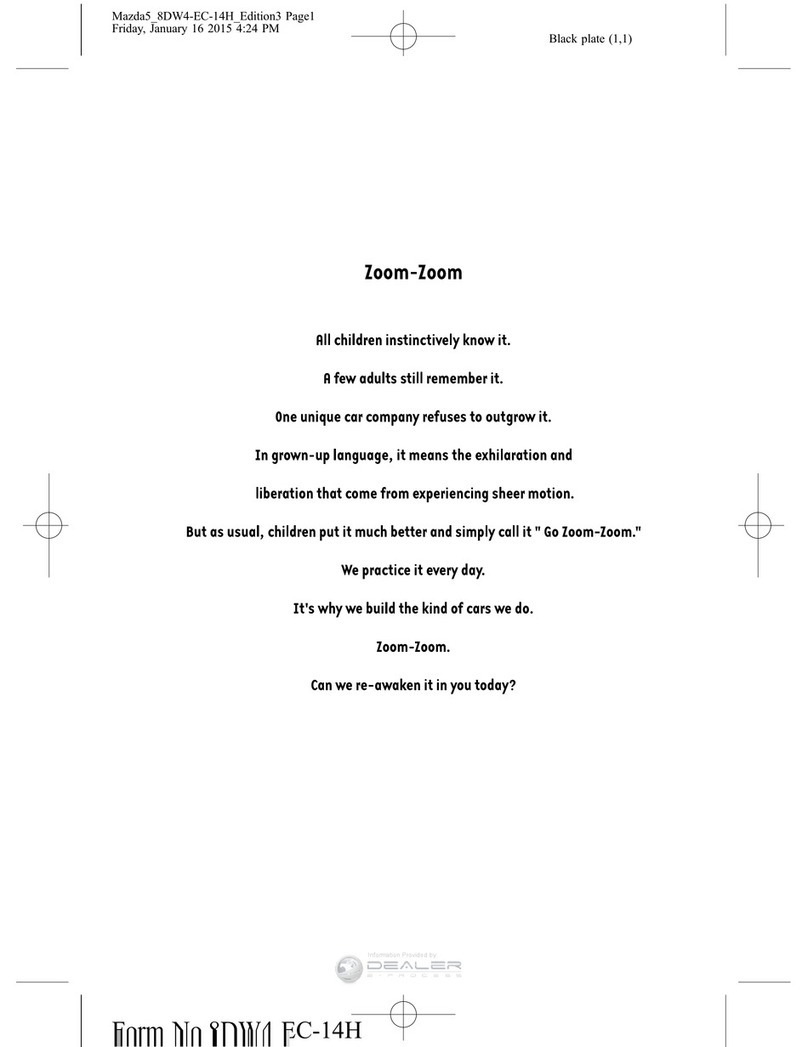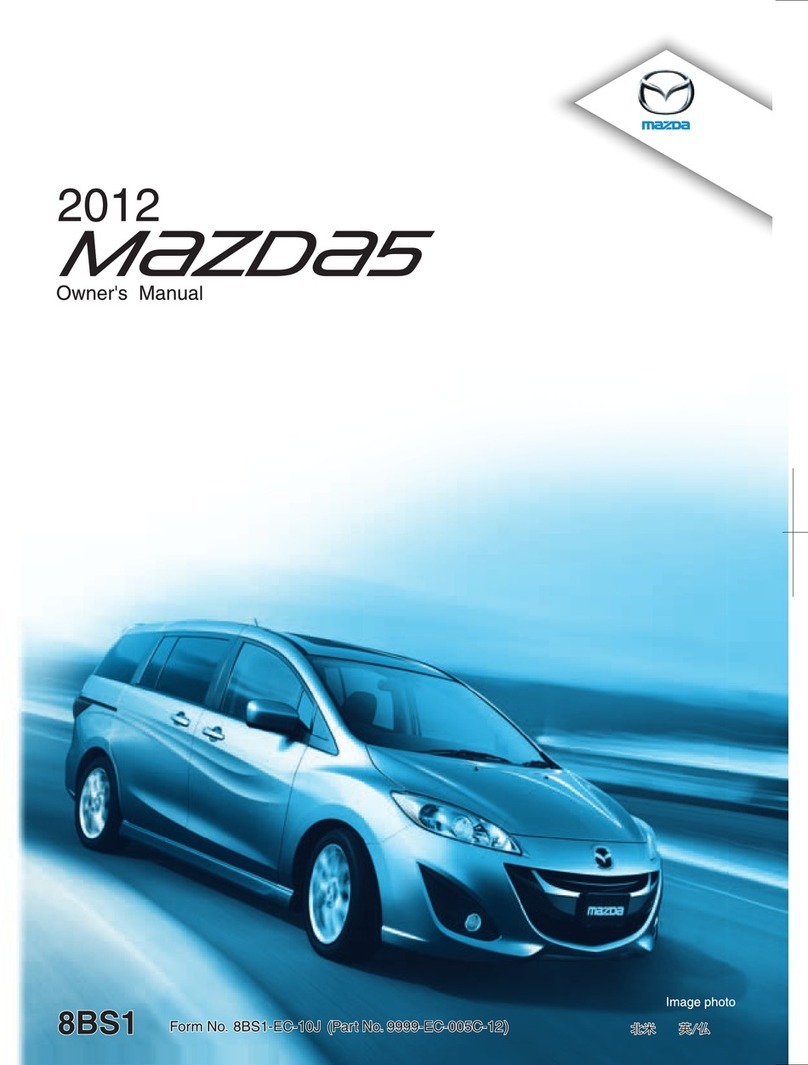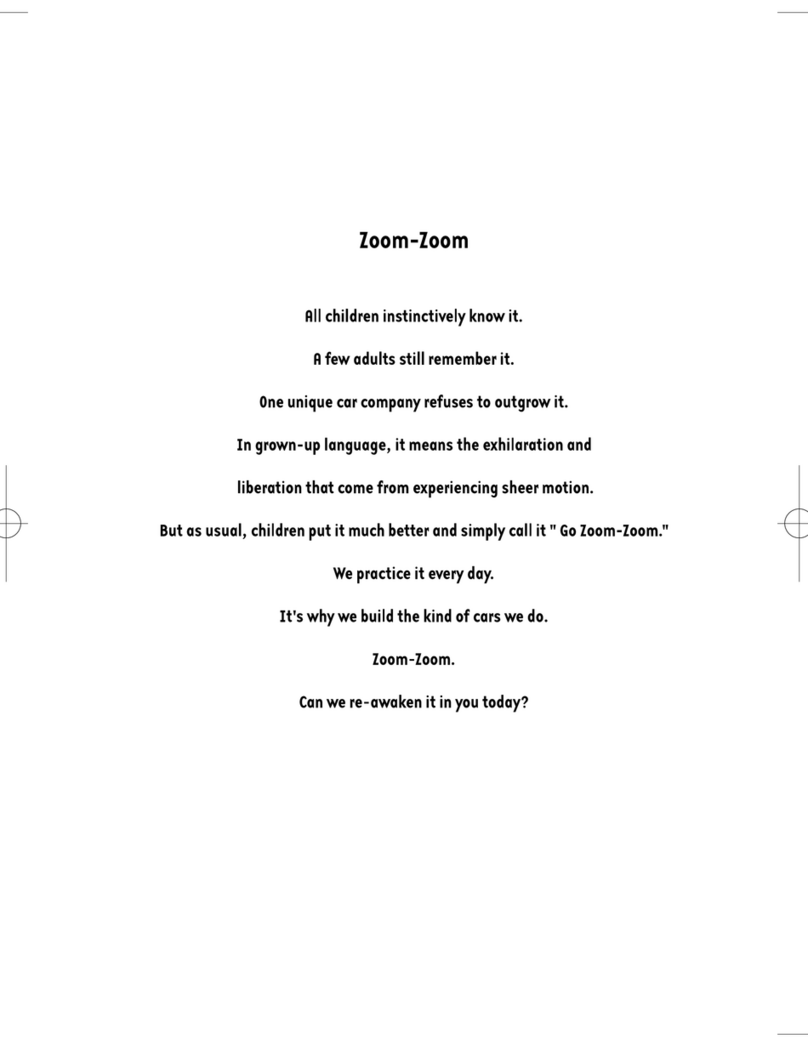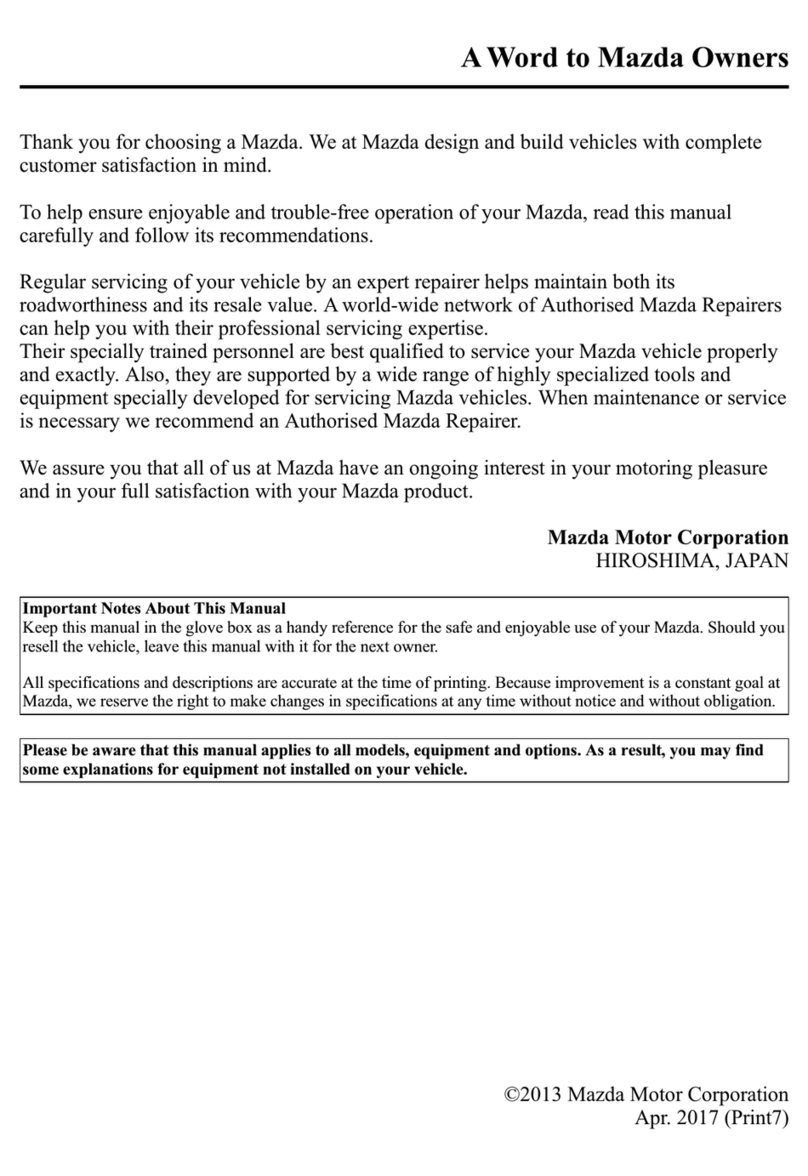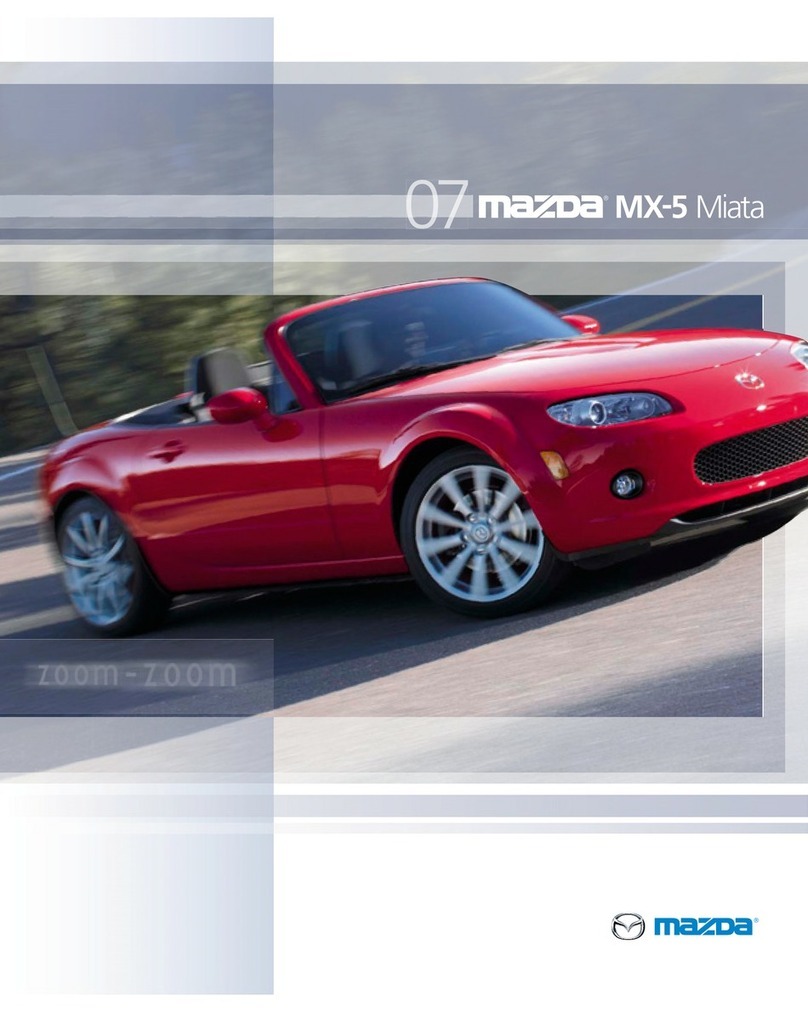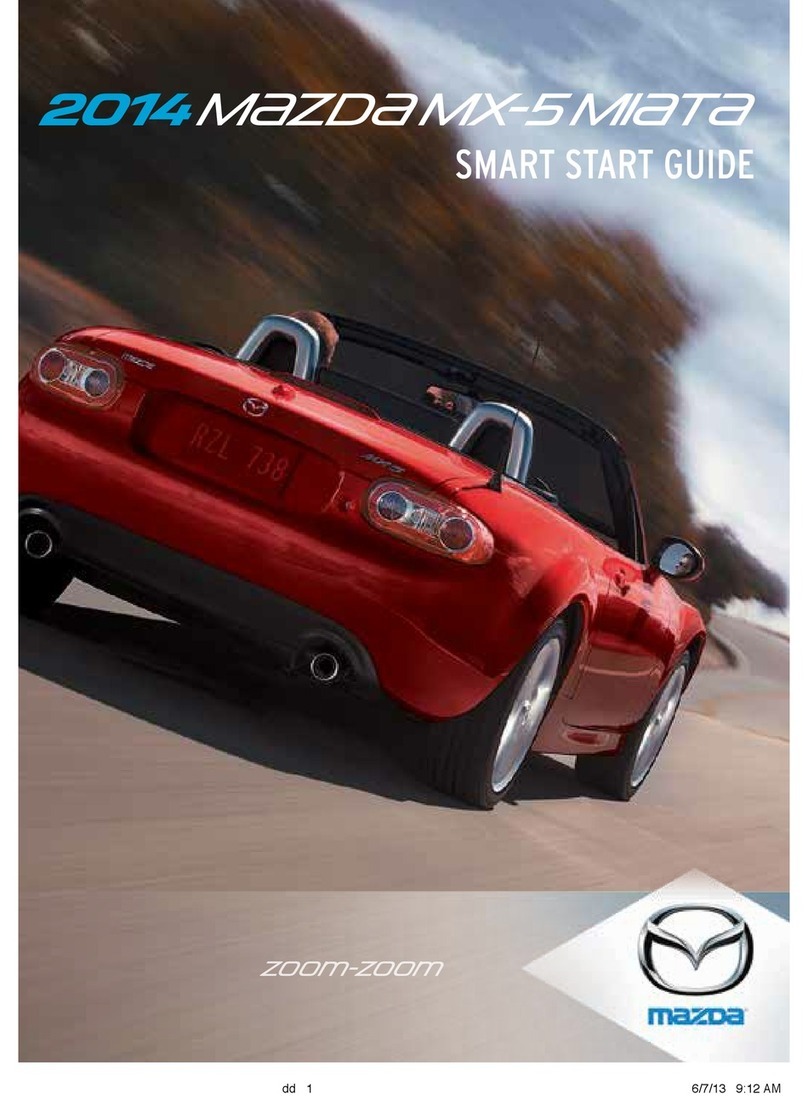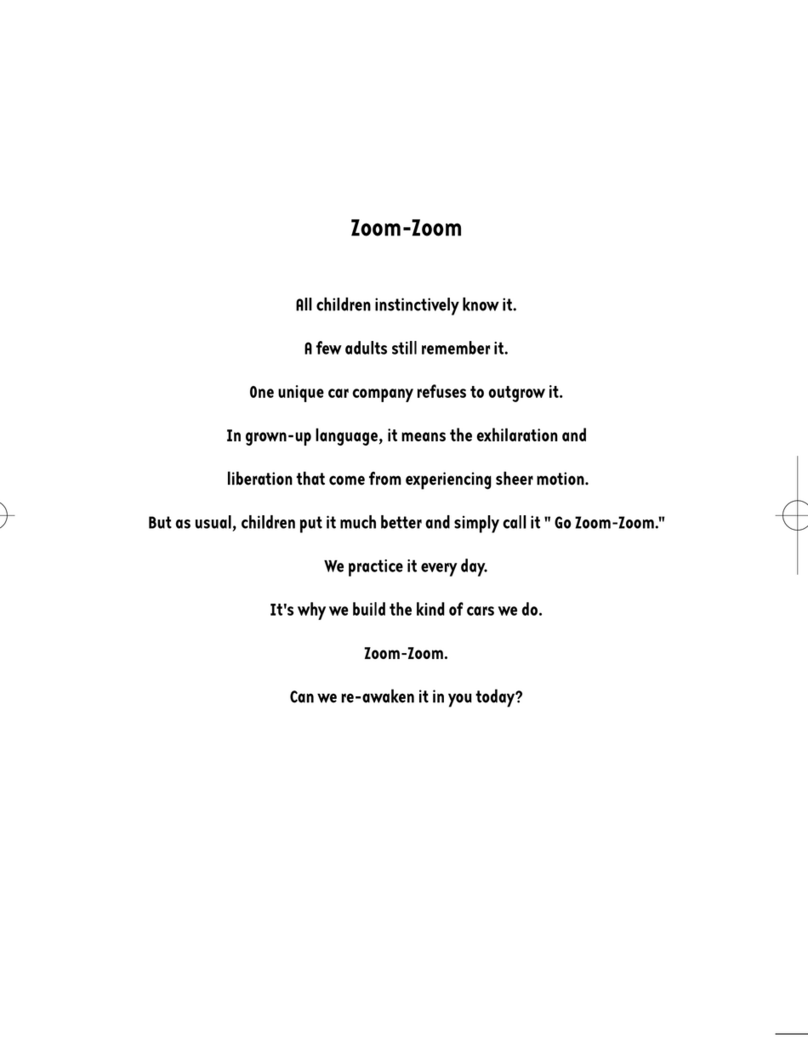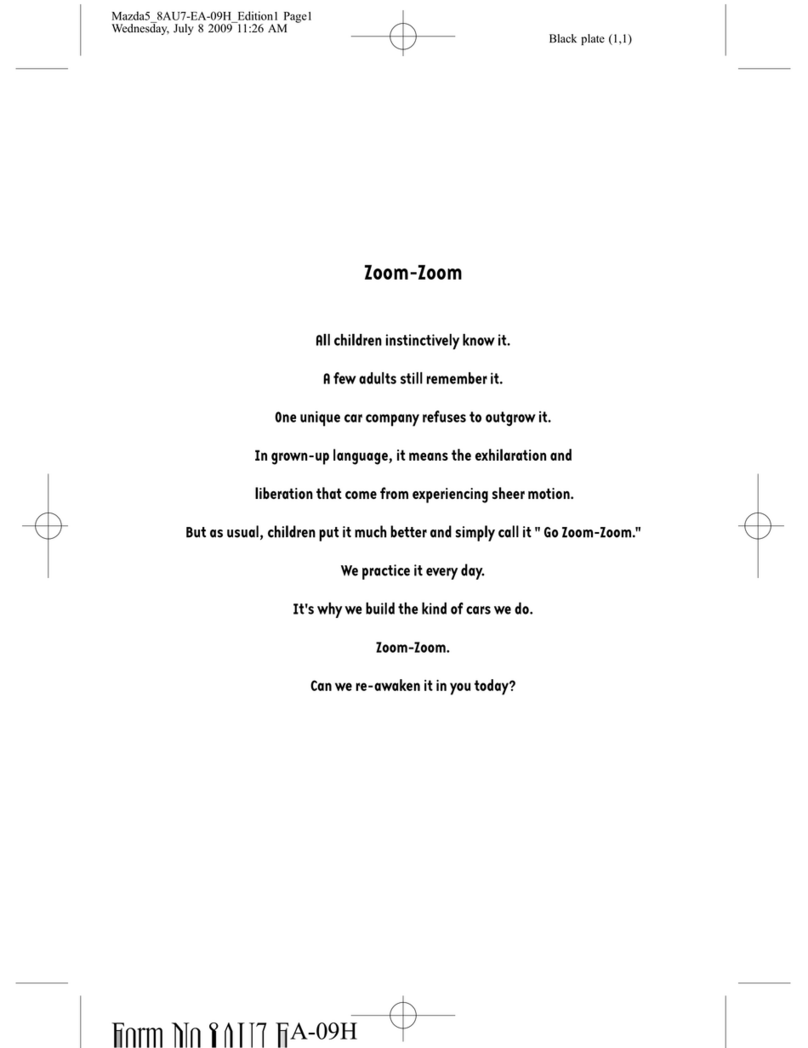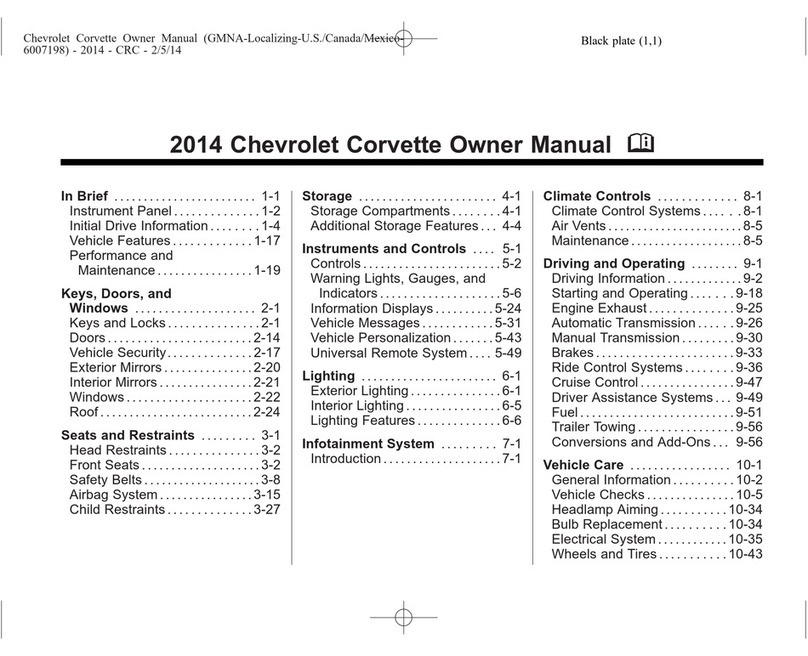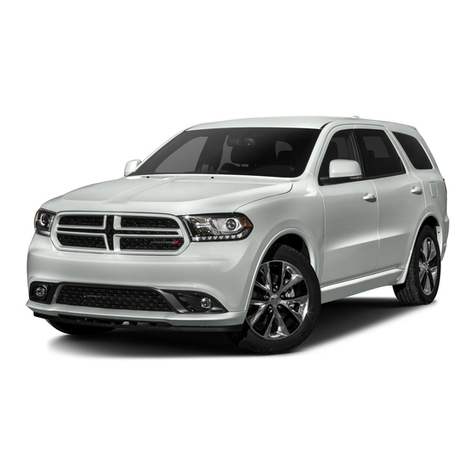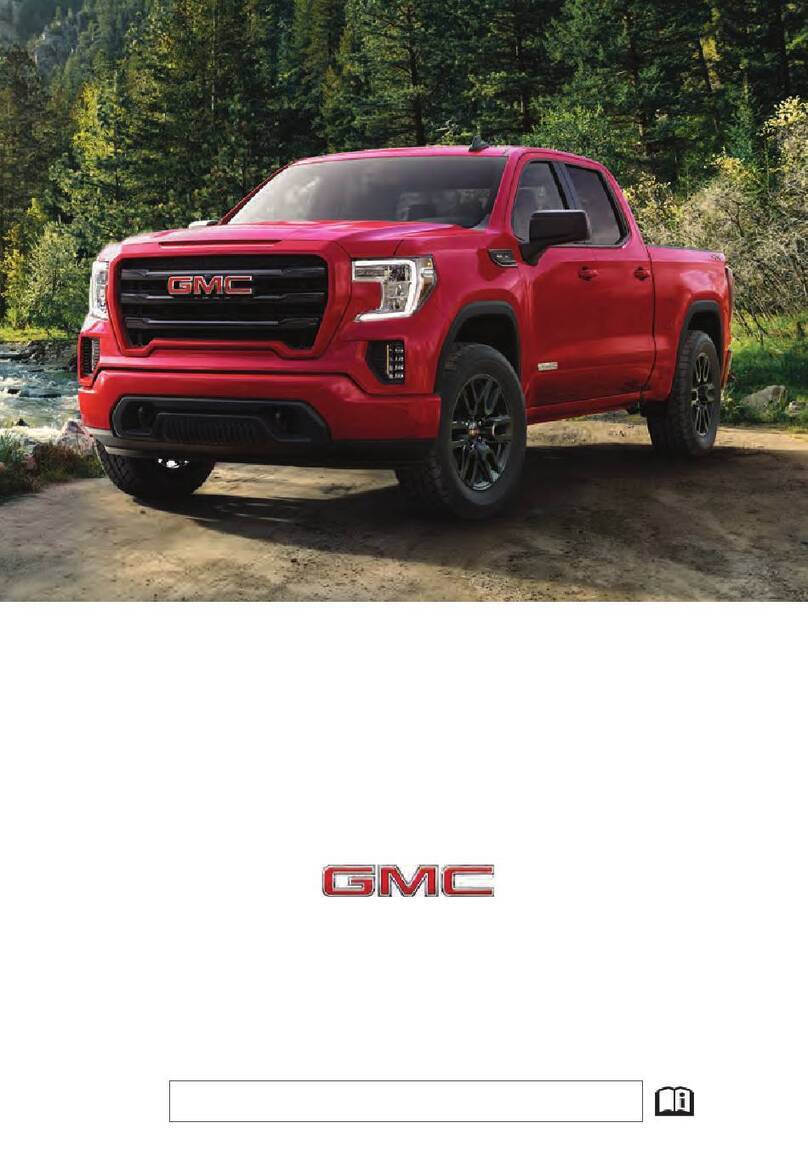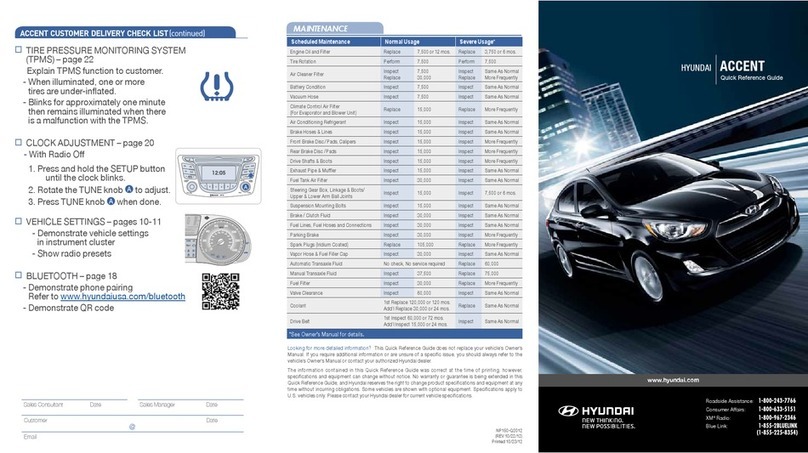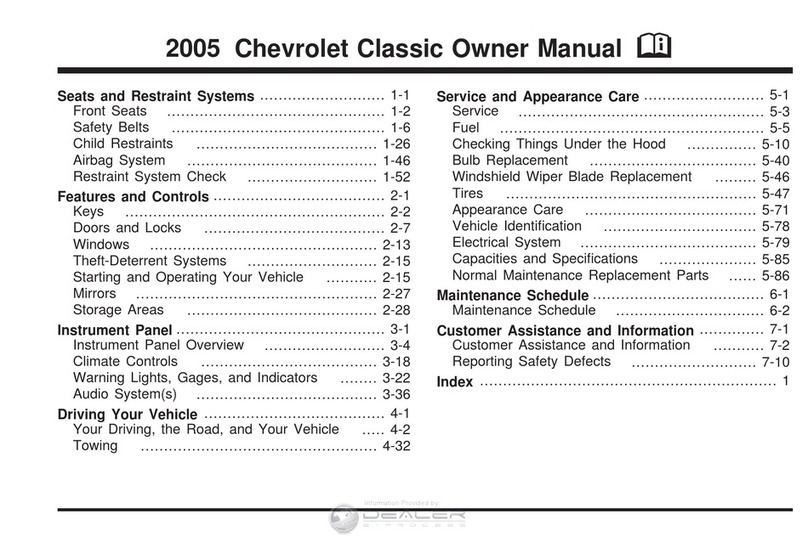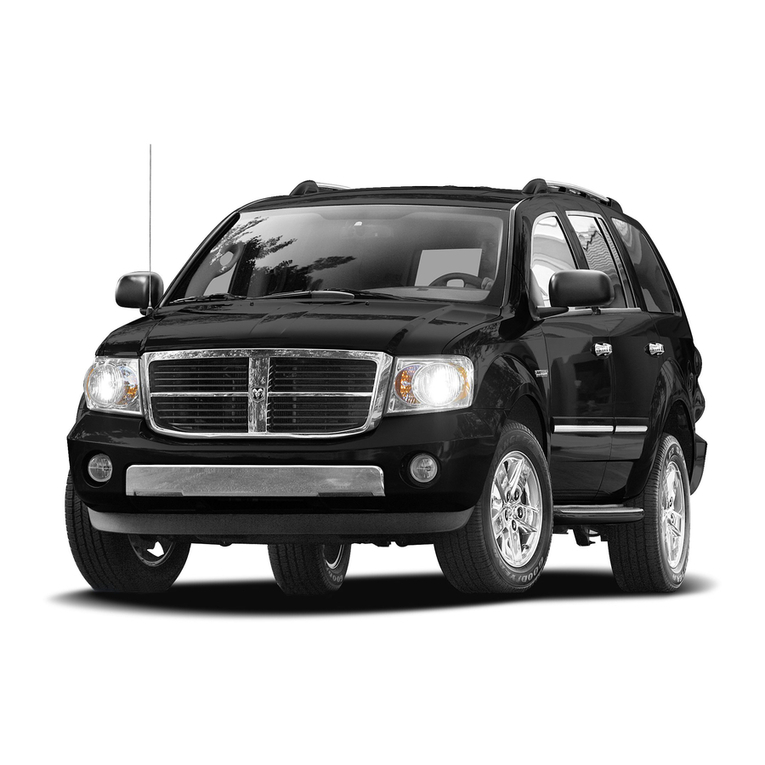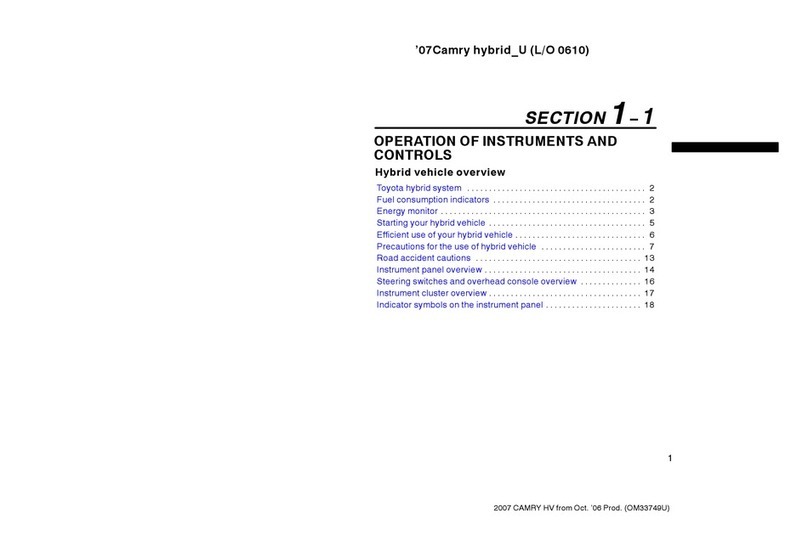Mazda 323 Protege Instruction manual

IV -- .-. .- --
i
-.
I .

Mazda 323
4-Wheel Drive
Workshop
Manual
CONTENTS
Title Section
Current ) NeH
Supplement
FOREWORD
This is a supplement to the workshop manu-
al(s) shown below. This supplement describes
service procedures of new or modified me-
chanical and/or electrical systems. For service
procedures and important safety notices not
contained in this supplement, please refer to
the previous workshop manual.
Workshop Manual:
Form No. 1203-I O-89F (Vol. I> Europe
1204-I O-89F (vol. I > Australia
I ZM-1 o-89F (vol.2)
Ali information in this supplement was the
latest available at the time of printing, all alter-
nations related to modifications wili be notified
by Service Bulletin.
Mazda Motor Corporation
HIROSHlMA, JAPAN
APPLlCATlON:
This manual is applicable to vehicles beginning
with the Vehicle Identification Numbers (UN)
shown on the following page.
Electronically Controlled
Wiring
Diagram
Refer to the form No.
5161-l O-89L
5162-t O-89L
Thrs manual explarns only the sectIons marked with
shadows ( )
0 1989 Mazda Motor
Corporation
PRlNTED IN JAPAN, Dec., ‘88 @$
1229-l O-891

VEHICLE IDENTlFlCATlUN NUMBERS (VIN)
Europe
JMZ BG8262 00 1000Uf-
JMZ BG8362 00 IUOOOl -
JMZ BG82F2 00
lOOOOl-
JMZ BG83F2 00 IOU001 -
JMZ
BG83H2 00 100001-
Australia
JMO BGI WI 00 IO0001 -

GENERAL INFORMATION
IMPORTANT INFORMATION ..................... GI- 2
BASIC ASSUMPTtONS ............................ a- 2
SAFETY RlSK
........................................
GI- 2
POSSBLE LOSS OF WARRANTY ............. GI- 2
WARNiNF ON LUBRICANTS
AND GREASES .................................... GI- 2
HOW TO USE THIS MANUAL.. .................. Gl- 3
PREPARATION ...................................... Gl- 3
REPAIR PROCEDURE ............................. Gl- 3
SYMBOLS
.............................................
a- 4
NOTES, CAUTIONS, AND WARNINGS ....... Gl- 4
FUNDAMENTAL PROCEDURES ................. Gl- 4
PROTECTION OF THE VEHICLE .............. Gi- 4
A WORD ABOUT SAFETY ....................... Gl- 5
PREPARATION OF TOOLS
AND MEASURING EQUIPMENT ............. GI- 5
SPECIAL TOOLS
....................................
Gt- 5
REMOVAL OF PARTS
............................. GI- 5
DISASSEMBLY ...................................... Gi- 5
REASSEMBLY ....................................... Gl- 6
ADJUSTMENTS
.....................................
GC- 7
RUBBER PARTS AND TUBING ................ Gl- 7
JACK AN5 SAFETY STAN5 POSITDNS .... Gl- 8
VEHICLE LIFT (Z-SUPPORT TYPE)
POSITIONS ............................................ GI- 8
TOWING .................................................. GL 9
IDENTIFICATION NUMBER LOCATIONS ..... GI-10
UNITS
..................................................... GI-I 0
ABBREVIATIONS ..................................... Gl-I 0
CAUTION ................................................ Gl-I 1
1NSTALLATtON OF A MOBlLE
TWO-WAY RADIO SYSTEM .................... GI-II
REMOVAL OF tGNIT1ON KEY ON
AUTOMATIC TRANSAXLE MODEL .......... Gl-11
ELECTRICAL TROUBLESHOOTlNG TOOLS GI-12
CAUTION WITH ELECTRICAL PARTS ........ Gl-13
03UGIX-001

GI
IMPORTANT tNFORMATlUN
IMPORTANT INFORMATION
1
.ftl
1
BASIC
ASSUMPTIONS
This workshop manual assumes that you have certain special tools that are necessary for the safe and effi-
cient performance of service operations on Mazda vehicles and that you know how to use
them
properly.
It also assumes that you are familiar with automobile
systems
and basic service and repair procedures. You
should
not
attempt to use this manual unless these assumptions are correct and you understand the conse-
quences described below.
SAFETY RlSK
This manual contains certain notes, warnings, and other precautionary information that you should carefully
read
and follow to reduce the risk of personal injury to yourself or others and the risk of improper service
that may damage the vehicle
or
render it unsafe. If there is no such information in regard to any specific
service method, this does not mean there is no possibility that personal safety or vehicle safety will be
jeopardized by the use of incorrect methods or toots.
POSSIBLE LOSS OF WARRANTY
The manufacturer’s warranty on Mazda vehicles and engines can be voided if improper service or repairs
are performed by persons other than those at an Authorized Mazda Dealer.
WARNING ON LUBRICANTS AND GREASES ’
Avoid all prolonged and repeated contact with mineral oils, especially used oils. Used 08s contaminated
during service (e.g., engine sump oils) are more irritating and more likely to cause serious effects, including
skin cancer, in the event of gross and prolonged skin contact.
Wash skin thoroughly after work involving oil.
Protective hand cleaners may be of value provided they can be removed from the skin with water. Do not
use gasoline, paraffin, or other solvents to remove oil from the skin.
Lubricants and greases may be slightly irritating to the eyes.
Repeated or prolonged skin contact should be avoided by wearing protective clothing if necessary. Particu-
lar care should be taken with used oils and greases containing lead. Do not allow work clothing to be con-
taminated with oil. Dry clean or launder such clothing at regular intervafs.
9MUGiX-502

HOW TO USE TtiIS MANUAL
GI
HOW TO USE THIS MANUAL
PREPARATION
PREPARATON points out the needed SpeciaI Service Tool (SST) for the service operation that it pro-
ceeds. Gather all necessary SST before beginning work.
Example:
MANUAL STEERING
PREPARATION
remova! of W-rod
REPAIR PROCEDURE
I.
Most repair operations begin with an overview illustration. It identifies
the
components, shows how the
parts fit together, and visual parts inspections. If
a
damaged or worn part is found, repair or replace it
as necessary.
2. Expendable parts, tightening torques, and symbols for oil, grease, and sealant are shown in the overview
iItustration.
3. Pages related to service procedures are shown under the illustration. Refer to this information when ser-
vicing the related part.
Example:
--__ __-
EXPENDABLE iI -
SHOWS TlGHTENlNG
TORQUE UNIT
-
SHOWS
Zh
REiAT&
PAGE
FOR
1 8oit
16 Bearing lnne
2. Lock plate Removal ..
,.
3. Bearrng cup I!.~ f%
fnstallatbon ._... ._. .....
I
A
Adirtstma drew
- _‘.v,--..s ----.
5. Bearing outer race :7 Spacer
G I h-tnllt
1R
hriu* mninn
I V.LVYR*IY. .” I.~.1
7Washer Rerr&l'~ .._. ......__ .........__......... page M---21
- -0mpanlon f&we inspect spllnes and teeth for
wear or damage
Adlustment of heloht ._._..... ..... DaPe k&Z? I
r..r...~r.--~.~r....e.-..c~~...~.,~.-* Q
SERVICE x
9MUGlx-034
‘I : The numbering (ex.@))
shows service procedure.
‘2: Units shown
in
N-m (m-kg, Wb) unless otherwise specified.

GI
HOW TO USE -MS lVlANUAL/FUNDAMENTAL PROCEDURES
SYMBOLS
There are six symbols indicating oil, grease, and sealant.
These
symbols show the points of applying such
materials during service.
Symbol
It
Meaning Kind
I
Apply oil New
engine
oil or
gear
oil as appropriate
Apply brake fluid Only brake fluid
Apply
automatic
transmission fluid
Apply grease
Only ATF
Appropriate grease
Appty sealant Appropriate sealant
m
0 Apply petroleum jelty Appropriate petroleum jelly
Note
l
When special oil or grease is needed, this is shown in the illustration.
NOTES, CAUTIONS, AND WARNINGS
As you read through the procedures, you will come across NOTES, CAUTIONS, and WARNINGS. Each
one is there for a specific purpose. NOTES give you added information that will help you to complete a
particular procedure. CAUTlUNS are given to prevent you from making an error that could damage the
vehicle. WARNINGS remind you to be especially careful in those areas where carelessness can cause per-
sona! injury. The foliowing list contains some general WARNINGS you should follow when you work on
a
vehicle.
9MUGlX-036
FUNDAMENTAL PROCEDURES
PROTECTON OF THE VEHICLE
Always be sure to cover fenders, seats, and floor areas be-
fore starting work.

FUNDAMENTAL PROCEDURES
GI
I
9MUGIX-003
I
SMUGIX-038
A WORD ABOUT SAFETY
The following precautions must be followed when jacking up
the vehicle,
3. Block the wheels.
2. Use only the specified jacking positions.
3. Support the vehicle with safety stands.
Start the engine only after making certain the engine compart-
ment is clear of tools and people.
PREPARATION OF TOOLS AND MEASURING
EQUIPMENT
Be sure that
all necessary
tools and measuring
equipment are
available before starting any
work.
SPECIAL TOOLS
Use special toots when they are required.
REMOVAL OF PARTS
White correcting a problem, try also to determine its cause.
Begin work only after first learning which parts and subassem-
blies must be removed and disassembled for replacement or
repair.
1
47ilOGX-006
1
DISASSEMBLY
If the disassembly procedure is complex, requiring many parts
to be disassembled, all parts should be disassembled in a way
that will not affect their performance or external appearance
and identified so that reassembly can be performed easily and
efficiently.
t
9MlJGIX439

GI
FUNDAMENTAL PROCEDURES
9MUGtX-040
SMLIGIX-041
SMUGIX-004
1. Inspection of parts
When removed, each part should be carefully inspected for
malfunctioning, deformation, damage, and other problems.
2. Arrangement of parts
All disassembled parts should be carefully arranged for re-
assembly.
Be sure to separate or otherwise identify the parts to be
replaced from those that will be reused.
3. Cleaning parts for reuse
All parts to be reused should be carefully and thoroughly
cleaned in the appropriate method.
REASSEMBLY
Standard values, such as torques and certain adjustments
must be strictly observed in the reassembly of all parts.
Refer to STANDARD BOLT AND NUT TIGHTENING TORQUE
in Section TD for tightening torques not mentioned in the main
text.
If
removed,
these parts should be replaced with new
ones:
1. Oil seals 2. Gaskets
3. O-rings
4.
Lock washers
5. Cotter pins 6. Nylon nuts
Depending on location:
1. Sealant should be applied to gaskets.
2. Oil should be applied to the moving components of parts.
3. Specified oil or grease should
be
applied at the prescribed
locations (such as oil seals) before reassembly.
‘31-6

FUNDAMENTAL PROCEDURES
GI’
I
ADJUSTMENTS
Use suitable gauges and/or testers when making adjustments.
I
67UOGX-002
RUBBER PARTS AND TUBING
Prevent gasoline or oil from getting on rubber parts or tubing.
5
Gl-7

GI
JACK AND SAFETY STAND PUSITIONSNEHICLE LIFT (2-SUPPORT TYPE) POSITIONS
JACK AND SAFETY STAND POSITIONS
FRONT END
Jack position:
At the front crossmember Safety stand positions:
On both sides of the body frame
REAR END
Jack position:
At the center of the rear crossmember Safety stand positions:
On both sides of the body frame
At the rear dtierential (4WD)
03UGlX-801
L j
03UGtX-010
VEHICLE LIFT (Z-SUPPORT TYPE) POSITIONS
FRONT END REAR END
Frame Frame
Side sills Side sills
I-
SMUGIX-Cl0
Gl-8
SMUGIX-011

TOWING
GI
i
e
I
I
:-
I
1
1
t
I
$
t
WHEEL tiOLLtES
I I
03UGIX-002
TOWING
Proper towing equipment is necessary to prevent damage to
the vehicle.
Laws and regulations applicable to vehicles in tow
must
al-
ways be observed.
As a general rule, towed vehicles should be pulled with the
driving wheels off the ground. If excessive damage or other
conditions prevent towing the vehicle with the driving wheels
off the ground, use wheel dollies.
With either automatic or manual transaxle:
1, Set the ignition switch in the ACC position;
2. Place the selector lever or shift lever in N (Neutral);
3. Release the parking brake.
Caution
l
50 not tow the vehicle backward with driving wheels
on the ground. This may cause internal damage to
the transaxles.
l
50 not use the hook loops under the front and rear
of the vehicle for towing purposes These hook
loops are designed ONLY for transport tie-down. If
tie-down hook loops are used fur towing, the
front/rear bumper wiIl be damaged.
TIE-DOWN HOOKS - FRONT
TIE-DOWN HOOKS - REAR

GI
IDENTIFICATION NUMBER LOCATIONSIUNITSIABBREVlATlONS
IDENTIFICATCON NUMBER LOCATIONS
I
VEHKZLE IDENTIFICATION NUMBER @‘IN) AUTOMATIC TRANSAXLE MODEL AND NUM8ER
ENGINE MODEL AND NUMBER
UNlTS
N-m (m-kg or cm-kg,
ft-lb or in-lb) ......._.......... Torque
rpm ._._..._.........._.._.._...._. Revolutions per minute
A ...._._._...__.._.._.._..__...._... Ampere(s)
v .._.....*.*.....__.._...*...*..*.,. Volt(s)
0I.._._............**..-.-*..-....... Ohm(s) (resistance)
Wa (kg/cm2, psi) .......... Pressure
(usually positive)
mmlig (inHg) ........_.._... Pressure
(usually negative)
w .....*.....e*.-..-..-.....*.e..... Watt
liters (US qt, imp qt) .._.Volume
mm (in) ,_._.._._..._.,_..~....__Length
89UOGX-006
ABBREVIATIONS
AB.DC ........................... After bottom dead
center
A/C _.............................. Air conditioner
ACC ............................. Accessories
ATX ............................. Automatic transaxte
ATDC ......................... Afier top dead center
ATF .............................. Automatic transmission
ftuid
BAC ........................... Bypass air control
BBDC.. ......................... Before bottom dead
center
BTDC ........................... Before top dead center
CPU ............................. Central processing unit t
EC-AT ........................... Ekctronically-controlled
automatic transmission
ECU ............................. Engine control unit
EGI ............................... Electronic gasotine
injection
EL ................................ Electricaf toad
EX ................................ Exhaust
IC ................................. Integrated circuit
IGN ............................... Ignition
IN ................................. Intake
tNT ............................... Intermittent
ISC ............................. Idle speed control
LH ................................ Left hand
M .................................. Motor
MIL ............................... Malfunction indicator
lamp
tb4TX. ............................. Manual transaxle
OD. ............................... Overdrive
OFF .............................. Switch off
ON ................................ Switch on
PCV
.............................. Positive crankcase
ventilation
PRC.. ............................ Pressure regulator
control
P/S ................................ Power steering
P/W .............................. Power wtndow
RH.. .............................. Right hand
SST ............................... Special service tool
ST ................................. Start
SW . ............................... Switch
TDC. ............................. Top dead center
4VVD ............................. 4-wheel drive

INSTALLATION OF MUBlLE TWO-WAY RADIO SYSTEM
If a mobile two-way radio system is installed improperly or if a high-powered type is used, the EGl system
and other systems may be affected.
When the vehicle is to be equipped with a mobile two-way radio, observe the fotlowing precautions:
I. Install the antenna at the farthest point from control units.
2. Install the antenna feeder as far as possible from the control unit harnesses (at Ieast 30 cm Ill.8 in]).
3. Ensure that the antenna and feeder are properly adjusted.
4. Do not install a high-powered mobile two-way radio system
r
CAUTION
GI
i
CRUISE CONTROL UNIT
FEEDER WIRE MOBILE TWO-WAY RADlO
\ CONTROt/UNlT HARNESS /
AT . LEAST 30 cm
(f1.3 in)
ENGINE C0NiROL UNIT /
FAR&T POlNT
REMOVAL OF IGNITION KEY ON AUTOMATIC
TRANSAXLE MODEL
The seiector iever must be in P (PARK) to turn the
ignition
key
to the OFF position. If the switch seems to be off but the key
cannot be removed, the switch may stilt be in the ACC posi-
tion, or the selector lever may not be in P (PARK). Shitt the
selector lever to P (PARK), and turn the ignition key to the
LOCK position. The key should now be free for removal.

GI
CAUTKN
SMUGIX-a21
I
VOLTMETER
1
9MUGlX-021
POWER SOURC
ELECTRICAL TROUBLESHOOTING TOOLS
Test Light
The test light, as shown in the figure, uses a f2V bulb. The
two lead wires should be connected to
probes.
The test light is used for simple voltage checks and for check-
ing for short circuits.
Caution
l
When checking the control unit, never use a butt,
over 3.4w.
Jumper Wire
The jumper wire is used for testing by shorting across switch
terminals and ground connections.
Caution
l
Do not connect a jumper wire from the power source
, line to a body ground; this may cause burning or
other damage to harnesses or electronic com-
ponents. -
Voltmeter
The DC voltmeter is used to measure of circuit
voltage. A volt-
meter with a range of 15V or more is used by connecting the
positive ( + ) probe (red lead wire) to the point where voltage
is to be measured and the negative (-1 probe (black lead
wire) to a body ground.
Diagnosis Connector
Insert the probe into the service hole when connecting a jum-
per wire to the diagnosis connector.
Caution
l
Do not insert the jumper wire probe into the diag-
nosis connector terminal, which may damage the
terminal.
Ohmmeter
The ohmmeter is used to measure the resistance between two
points in a circuit and atso to check for continuity and diagno-
sis of short circuits.
Caution
l
Do not attempt to connect the ohmmeter to any cir-
cuit to which voltage is applied; this may burn or
otherwise damage the ohmmeter.

CAUTION
GI
i
I
9MUGIX-022
\
9MUGIX-02:
9MUGIX-02
CAUTlON WITH ELECTRICAL PARTS
Battery Cable
Before disconnecting connectors or replacing electrical parts,
disconne@ the negative battery cable.
Connectors
Removal of connector
Never pull on the wiring harness when disconnecting con-
nectars.
Connectors can be removed by pressing or pulling the lock
lever as shown.
Locking of connector
When locking connectors, make sure to listen for a click that
will indicate they are securely locked.
Inspection
1. When a tester is used to check for continuity or to measure
voltage, insert the tester probe from the wire harness side.
Gl-13

I
OWGIX-028
1
SMUG IX-027
gMi)GlX-03
GI-i4
2. Check the terminals of waterproof connectors from the con-
nector side, as they cannot be accessed from the wire har-
ness side.
Caution
l
Use fine wire to prevent damage to the terminal.
l
Do not damage the terminal when inserting the
tester lead.
Terminals
Inspection
Pull lightly on individual wires to check that they are secured
in the terminal.
Replacement of terminals
Use the appropriate tools to remove the terminal as shown.
When installing the terminal, be sure to insert it until it locks
securely.
Insert a thin piece of metal from the terminal side of the con-
nector, and then, with the terminal locking tab pressed down,
pull the terminal out from the connector.
< Male >
Same as the female type,
Sensors, Switches, and Relays
Handle sensors, switches, and relays carefully. Do not drop
them or strike them against other parts.
4
I
i
c

CAUTION
GI
I
9MUGIX-031
PULLER
t
Fuse
Replacement
1. When replacing a fuse, be sure to replace it with one of
specified capacity.
If a fuse again fails after it has been reptaced, the circuit
probably has a short circuit and the wiring should be
checked.
2. Be sure the negative battery terminal i
fore replacing a main fuse @A).
3. When replacing a pullout fuse, use the
in the fuse box cover.
; disconnected be-
use puller supplied
Wiring Harness
Wiring color codes
Two-color
wires are indicated by
a two-color code symbol.
The first letter indicates the
base
color of the wire and the sec-
ond the color of the stripe.
1
9MUGIX-029
LG Light Green - -
CODE
B
COLOR
Black
CODE )
0
COLOR
Orange
BR Brown P Pink 1
G
GY
t
LB
Green
Gray
Blue
Light Blue
R ! Red
V Violet
W White
Y Yellow
Gl-15

-

1
I
PRE-DELIVERY INSPECTION
AND
SCHEDULED MAINTENANCE
SERVICES
PRE-DELIVERY INSPECTION TA8LE ..-*...a.. A- 2
SCflEDULED MAiNTENANCE SERVICES
(Australia)
. ..* . . . . . . . l . . . . . . . . . . . . . . . . l .*..* . . . . l . . . . . . .
A- 3
SCHEDULED MAINTENANCE SERVICES
(Europe)
. . . . . . . . . . . . . . . . . l . . . . . . . . . . . . . . . . . . .*..* . . . . . . . .
A- 5
93GOAX-701
Other manuals for 323 Protege
3
Table of contents
Other Mazda Automobile manuals

Mazda
Mazda 2007 MX-5 Miata User manual

Mazda
Mazda CX-30 User manual

Mazda
Mazda 3 2007 User manual
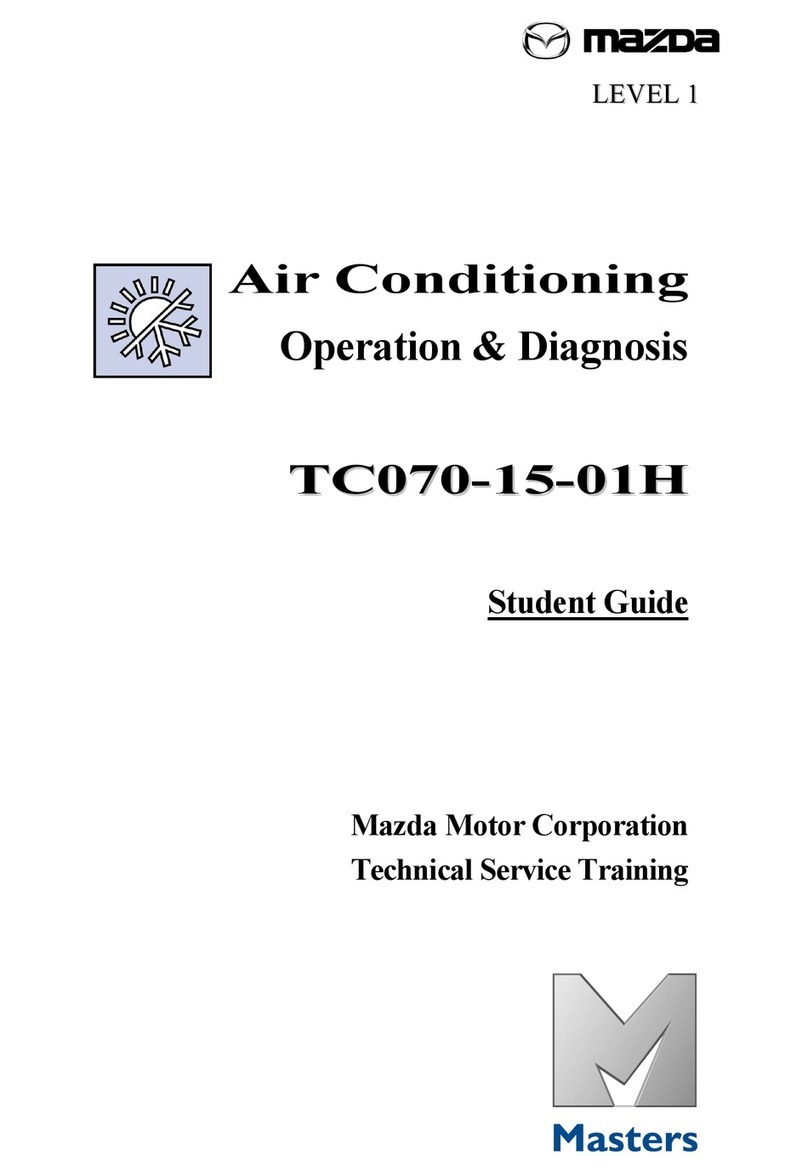
Mazda
Mazda TTCC007700--1155--0011H User manual

Mazda
Mazda 2010 Mazda3 4-Door User manual

Mazda
Mazda 2012 CX5 User manual

Mazda
Mazda 6 20014 Guide

Mazda
Mazda 2010 CX-7 Guide

Mazda
Mazda 1975 Rotary Pickup Instruction manual

Mazda
Mazda Mazda 6 Guide




